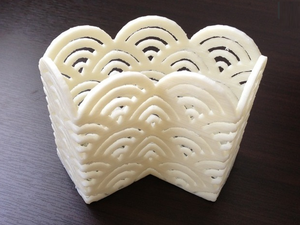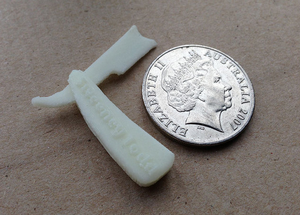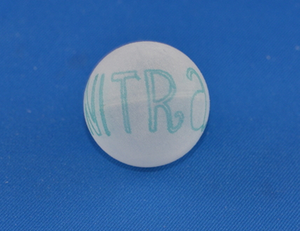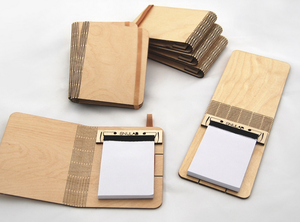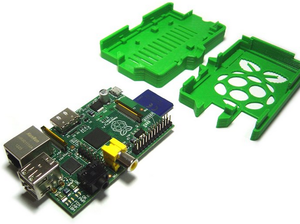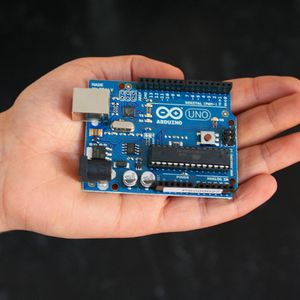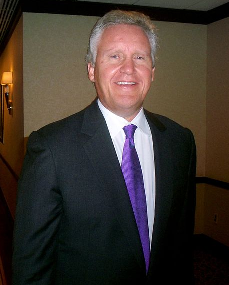User:Avl5279/Blog
Main | About Me | Class Blog
For this class we write weekly blogs on a variety of topics that have to do with 3D printing.
Contents
Blog 1: Thingiverse
We had to explore around on Thingiverse and find different items.
An item that is amazing/beautiful
Here's a gorgeous Japanese-style folding screen with an ocean print. The design is both beautiful and simple although it looks complicated. I love the repeating pattern of the sides and the details on the bottom. Source
An item that is funny or strange
One of my favorite movies is Sweeney Todd and I found (by cleverly using the search bar) this Sweeney Todd razor. If you haven't seen the movie or musical, you probably would put this in the useless category, especially because it's probably not sharp enough to cut anything. But I think it's a fun print, even if it would be weird to randomly whip out. If you don't know what the movie about, Sweeney Todd is a barber and his accomplice is a pie maker (see if you can make the connection). Source
An item that is useless
This ping pong ball seems really pointless. If you wanted customization, you could probably use sharpie or acrylic paint on a regular ping pong ball and draw whatever you wanted. Also, I think it would be extremely difficult to print out a sphere perfectly, and having an imperfect ball would really effect a ping pong game. Source
An item that is useful
This is a cool print of a fold-able booklet. They didn't go into much detail of the technique they used but it is definitely unique, probably because I haven't seem that many wood prints. I think it would be cool to customize the front of the booklet, too. For example, you could have your name "engraved" on the front. The creators also mentioned how combining steps and using simple designs allows for cheaper production which is what I think a big part of 3D printing is. Source
The best printable Raspberry Pi case I could find
This was the best case that I could find. It had a lot of made versions and a lot of likes. It also allows for customization of the case, because the cut-out holes (that are in the shape of a raspberry in the original version) can be changed (there are some examples in the collection of "I Made One" pictures). The instructions also include a detailed blog post which seems useful for trouble-shooting and gives a lot of credibility to the creators. Source
Out of all the prints I found, none of them really surprised me. I'm not entirely sure how the wood booklet one prints and I'm a bit surprised/confused that someone would print a ping pong ball. I also am still not sure how printing with supports looks like so I would be interested to see that, but not surprised by the outcome, since classmates have already explained how supports work.
Blog 2: Topics of Interest
Write about a topic (or two, or three) which interests you which we've discussed so far - or not discussed in detail yet. It could be your project, or a particular type of 3D printer, or something you think would be cool for us to explore in the future.
Something that really interests me is the mix of a scanner and a printer. I used a 3D scanner while in a summer engineering program] in Nantes, France. It was really interesting and could definitely have a lot of uses. For example, in our program we scanned the Wii U controller. Once the 3D model was complete, it could be loaded onto the computer and edited with a CAD program. Using technology like this could make for relatively cheap and easy prototypes for new products.
Something else that I find fascinating is nanotechnology. I haven't really done too much research on it, but I know that it is similar to 3D printing, where you can build unique things. I mostly read about it in a book called Uglies, where the characters live in a technologically-advanced dystopian/post-apocalyptic society (that also involves hover-transport!). In their world, you could pretty much ask for anything and the "hole in the wall" would spit it out. When you were done with it, you threw it back, and it would break down into particles again that could be used for something else. (Similar to the recycler that we want to build for our printers).
Something else we've talked a little more about in class, is a topic that involves the dual-extruder printer. Someone mentioned being able to build supports that are easier to break off. For example, one extruder could use a material that is soluble in water while the other uses regular plastic. The final result would require just dipping the figure in water to get rid of the supports (instead of breaking it, which is what I assume they've done so far). Also someone mentioned being able to print with edible materials, which I think would be soooooo awesome because I love food (and it would definitely bring into discussion the idea of printing food in the future. I'm not entirely sure how the ingredients would work though... would you have some solid form of sugar and flour to make a baked good for example?????)
Blog 3: Blog Responses
This week we had to find classmates' blogs and pick some of our favorites. We also gave constructive criticism. I decided to choose a favorite post for each week so far (so one from week 1 and one from week 2). I also decided to add a section on commentary because I found some posts that weren't my favorites or didn't need much improvement but I wanted to give my opinion on something.
Best posts
I thought this was one of the best blogs for the second week. I think Brandon took a semi-complicated topic (digital rights management) and broke it down so it was easy to understand. He connected it well with the class and what we're doing, and other real-world examples like the music industry. He cited great sources. Aesthetically, adding pictures and changing the format of the sources would be an improvement, in my opinion. Also, he could have added a paragraph on his personal opinion or what he thinks would be an appropriate solution.
This was one of my favorites for week one. Thomas gave great explanations for his choices. He also included sources and pictures and formatted it well. (My favorite format was Dimitar's though!) Something he didn't do was talk about whether or not he was surprised by the choices. But I found a lot of people forgot that component of the blogs. (I did as well, but I edited my response in as of now haha). Also his STL links weren't formatted correctly.
A small note; in his second post some paragraphs would be nice. It's a big chunk of text on a fairly difficult to understand topic (although that could just be me).
Blogs that could use improvement
In the Thingiverse blog, the things he found were cool, but he didn't give much reason for why he picked them. A little commentary to get a feel for his thinking process would have been nice. Also the addition of pictures would be nice so the reader doesn't have to open a new page to view what items he chose.
The Thingiverse post is all right. Pictures would help in my opinion. He also has a few spelling/grammatical errors which should have been highlighted in the editor. His second post does not have much content. In my opinion, he could have responded to the links provided by the professor in the prompt to add more content.
Other posts I'd like to comment on
This is more of a disagreement than a blog that needs improvement. His first blog is well-written and explained and includes pictures which is great. But in his section C, for something useless, I think he's incorrect about action figures. Action figures, I think, a big appeal of 3D printing for the more casual/hobbyist 3D print-ee (person who uses 3D printers xD), especially after reading Brandon's post on DMR. Also, the figure he chose is not just a random figure. I'm pretty sure it's actually Danbo, a cardboard robot. Without a link provided in Matt's post, I can't tell if he was misled but a lacking description on Thingiverse.
Dimitar had my favorite formatting for the Thingiverse blog post. I think the chart looks very clean and it gives a great spot for the picture. He didn't give very in-dept explanations and some of the source formatting is off (OCD of me, I know), but he was the only one that used the chart.
Going along with improvements, it would be nice if some pictures were included. But I'd really like to respond to the first half of his second blog. The idea of different extruder sizes and shapes is really interesting. I'm not sure how it could be possible, though. The only thing I can think of is different tip heads we could put on the hot tip? But that would take more time and make the point of changing holes pointless. I do think it is an original topic to think about and it would be interesting to see if someone could create something like that.
This was one of my favorites for the second prompt. I thought the topic was very interesting and very applicable to our class, especially because the lab is similar to a hub for the EDSGN 100 classes. I think cited sources would be beneficial.
A small note on the first post, I think it would be best to put the links to each item he chose next to the description so the reader doesn't have to scroll back up and down to read his explanation and see the picture.
Hidden blogs
There should be 23 people in class but there are only 21 blogs listed.
After some snooping I found Peter's blog!
Blog 4: Arduino and RepRap
This post is a response to this video.The Arduino proyecto definitely seemed interesting. It reminded me of a computer science tool I used in high school called Alice. It was basically trying to teach the logic of computer science and coding without actually coding. I thought it was a simple way to get started into coding. I think the Arduino (I keep typing that incorrectly!) is similar in that it allows someone to bypass the usually difficult beginnings of something new and lets them jump straight into the "fun" stuff.
However, I still am a bit confused with the Arduino in general. To me, it still looks really complicated but I'm assuming by the statistics in the Keynotes speech that it's a great product.
The idea of Reprap was definitely easier for me to understand, especially since I've worked with them first-hand. A great analogy for the Arduino is the fact that I'm able to use and print things from the Repraps, even though I don't know how to make one myself.
The Business Model
The business model of giving something away for free seems counterintuitive. If you have something, and give it to someone else, you've just created more competition for yourself! But as the video explained, a lot of companies (e.g. Google) have adopted this model and are becoming successful through it.
In addition, the speaker made some points that make a lot of sense. Not worrying about copyright and getting feedback from a large amount of people is essential in the early stages of an industry. Although the speaker said 3D printing started 30 years ago, it still is very new and a lot of people haven't had any contact with a 3D printer or a 3D printed object yet. Having users collaborate and improve the printers will allow for more advances than if everyone was competing with each other and keeping ideas to themselves. As James Cash Penney said, "growth is never by mere chance; it is the result of forces working together." (Yes, I had to Google "working together quotes" for that one.)
Another thing that this business model reminds me of is Youtube. The users on Youtube who make videos allow people to view them free of charge. However, successful Youtubers will gain royalties off of ads based on how many views their videos get. It's a little different than the data-mining examples like Google and Facebook, but I think it belongs it that category because the primary goal of Youtube videos is to share content.
Blog 5
Blog 6
Blog 7
Blog 8
Blog 9
Blog 10: Immelt and Gou
Jeffrey R. Immelt
Jeffrey R. Immelt is the current CEO of General Electric. He also happens to have the same birthday as me! Immelt has had an extremely positive response to 3D printing.
He has said that GE has been interested in 3D printing for quite some time, and that GE has been trying to integrate the process into their products, more specifically, new jet engines.
As a CEO of one of America's largest companies, it makes sense that Immelt is trying to do new things to keep GE on top. It is a smart move to go along with trends. 3D printing is becoming well-known, and it gives GE a good reputation when the CEO supports new, very popular technology.
In addition, based on the article, it seems Immelt is focused on efficiency, customization, and cost reduction. By spending less and making more faster, it means more money for the business (and for Immelt's pockets). All companies should constantly be looking for ways to reduce production cost and for ways to incorporate new technologies. Another point to add is that customization is also very important. People like things to be "their own," and appealing to that side of people is partially why 3D printing is so big.
Terry Gou
Terry Tai-Ming Gou, sometimes written as Terry Guo, (traditional Chinese: 郭台銘; simplified Chinese: 郭台铭; pinyin: Guō Táimíng) (born October 8, 1950 in Banqiao Township, Taipei County) is a Taiwanese tycoon who is the founder and chairman of Foxconn,[2] a company that manufactures electronics on contract for other companies - such as Apple Inc.. It is the largest such electronics manufacturing services company in the world, with factories in several countries, mostly in mainland China, where it employs 1.2 million people and is its largest exporter.[3]
3D printing does not herald the arrival of the third industrial revolution, said Terry Gou, the president of Foxconn Technology Group, the world's largest electronics contract manufacturer.
Gou described the fledgling manufacturing process as nothing more than hyperbolic gimmickry. "If it really is that good, then I'll write my surname 'Gou' backwards." said Gou to Taiwan media on Monday.
"3D printing is a gimmick", said Gou. He explained that Foxconn had been using 3D printing for nearly three decades. However 3D printing is not suitable for mass production, and it doesn't have any commercial value, said Gou.
Citing the example of a mobile phone, Gou said that it might be possible to manufacture a phone model using 3D printing, but it will not be operational. 3D printers could not assemble electronic components or mass produce them. In addition, Gou said 3D printers were currently incapable of printing leather, that means 3D printed products are very fragile and unsuitable for daily use.
Any industry should response quickly to market demands, 3D printing was not necessarily the key to manufacturing's future, said Gou. Foxconn was originally a trade name of Hon Hai Precision Industry Co., Ltd. and was founded by Gou in 1974. It is estimated that Foxconn assemble around 40 percent of all consumer electronics products sold. It's major customers include Acer, Amazon, Apple, Cisco, Dell, Google, HP, Microsoft, Nintendo, Nokia and Sony, etc. Gou said, Foxconn's success relies on its diversified product integration.
Despite Gou's dismissive outlook toward 3D printing, the process has become a global trend over the past year and has been adopted by various companies across industries. The consumer electronics giant Panasonic recently announced that 3D printers will be used to produce parts needed for the production of molds, and Panasonic estimates that the production cost could be greatly reduced by approximately 30%.
Blog 11: Pondering Printing Problems
I haven't been too frustrated with things in the class really. The most annoying day was when I came in late at night to print and I couldn't get anything to work. Luckily the next class I was able to print and it felt great! Some other things that are bothersome are putting together parts that need to be taken apart because they were in the wrong order.
Of course, if you want to see me confused, just hand me a circuit and some wires and tell me to set up a printer. I think the reason I haven't been too stressed in the class is that I'm doing sort of the "busy work" side of things. I think what I help out in is important, but I also think any able-bodied human could do it. Having no background in electrical or mechanical engineering (I currently major in Gen Eds), there wasn't much I could bring to the table. (At least, not much in the beginning of the semester. I'm sure if I sat down and focused on something for a while I could be able to do it, although I feel like other students would be better at it and there wouldn't be a need for initial "training.")
I'm still working on the Blue and White printer when they need help. Now that it's down to the end, and more electrical things are being done, I've been putting more time into good 'ol Rainbow again. It's sort of therapeutic just manually working with the screws and parts. It has been difficult to find a concrete plan for Rainbow though. It would be nice if someone made a "Building a OHM RepRap for Dummies" book.
